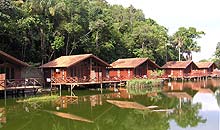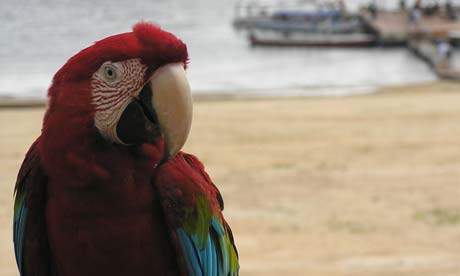This is apparent when you meet Cabeçao, the macaw that has adopted the place as his personal fief. Three feet long from the tip of his menacing beak to his furthermost iridescent plume, the bird makes no bones about who is the lucky visitor and who is the grudging host.
If you've only seen a macaw in a zoo or a pet store, prepare yourself. The real thing blasts off like a rocket and then cruises like a Stealth fighter, its airborne silhouette equally distinctive. He is the noisiest thing you will hear.
 Tiwa's cabins stand round the lagoon. Photograph: Denis Seguin There are no rooms at Tiwa: rather each guest has a spectacular semi-detached cabin built of local hardwoods. Perched on poles, 26 such cabins ring a lagoon over which Cabeçao and his colourful peers provide a morning air show. Then it's a short stroll to the open-air restaurant and lounge. If only Byron were here to expand upon the ecstasy of the breakfast juices. Taperebá is a caramel-colour elixir somewhere between the texture of mango juice and the bitterness of grapefruit, but without the cloying sweetness of the former nor the acidity of the latter.
Tiwa's cabins stand round the lagoon. Photograph: Denis Seguin There are no rooms at Tiwa: rather each guest has a spectacular semi-detached cabin built of local hardwoods. Perched on poles, 26 such cabins ring a lagoon over which Cabeçao and his colourful peers provide a morning air show. Then it's a short stroll to the open-air restaurant and lounge. If only Byron were here to expand upon the ecstasy of the breakfast juices. Taperebá is a caramel-colour elixir somewhere between the texture of mango juice and the bitterness of grapefruit, but without the cloying sweetness of the former nor the acidity of the latter. Tiwa's owners are justly proud of the resort's ecologically-sound practices — the sewage from the guest cabins is treated on site before being returned to the lagoon — but it is the resident rain forest guide, Mr Anderson, who best exemplifies the difference between theory and practice. Walking through the forest in his silent wake brings you face-to-face with unspeakable diversity one metre in either direction from the path.
A soft-spoken 24-year-old from the country's north-east region, Anderson Oliveira treads softly and carries a machete that does everything but receive mobile calls. He pauses, he crouches, he pokes a stick into a hole and extracts a 4cm ant, the tucandeira, whose sting will leave you begging for wasps. He picks up a pygmy coconut and taps the machete against its outer shell. "The moth lays its eggs in the flower," he explains as he taps. "Its young feed on the coconut juice." The walnut-sized fruit splits evenly and exposes a plump larva. "Pure coconut," he says. "Here, try it."
I do. Essence of coconut with just the wrong sort of crunchiness.
We move on. He points to a huge improbable hillock attached to the side of a tree. The word "termite" drives a stake into the heart of a home-owner but here the lowly bug is a divine presence. The rain forest would not exist without the termite and its life-giving appetite for humus. It seems counter-intuitive, given the lush surrounds, but rain forest soil is generally poor. Clear the trees and what's left will wash away with the rain; clear-cut the rainforest and it will never grow back.
A fist-sized hole at the base of a tree invites Oliveira's probing stick. No one is home. Under a frond we find the tenant dead, a palm-sized tarantula. "It's the season," says Oliveira, explaining the Shakespearean end-game of the spider's sex life. The female reaches maximum size, breeds with, then kills her mate and then dies. I pick up the corpse.
"Never pick up a tarantula," he says. "Not even a dead one." I put down the corpse. The hairs are covered with allergens that bring out a rash. He pulls out some disinfectant and I wash my abashed hand. He doesn't dwell on my indiscretion; he's seen dumber moves.
Another tree, this one cracked open and teeming with tiny tapiba ants. Incredibly, he puts his hand into their melee. It's rapidly covered with ants which are as quickly pulverised by the laving of his other hand, as though he just pumped soap. "Smell," he says, holding out his brown-smeared hand. A pungent but not unpleasant earthiness. "Smell camouflage," he says. "The Indians use it for hunting. You have two or three seconds before the ants start biting."
Animals need three things: food, water, rest. Reeking benignly of ant slime, aboriginal hunters triangulate on these bare necessities and then sling hammocks between trees three metres above the forest floor, above the olfactory radar of their quarry. Then they wait. Even in 10,000BC, we humans were too clever by half.
After 90 minutes' walking through a wall of humidity, the Tiwa's pool is a necessary destination. The water is a cooling 80F and my beer considerably cooler. Suddenly Cabeçao appears pool-side, demanding a photo. When I comply, he pecks at the lens and my recoil nearly drowns my camera.
The chef has prepared pirarucu, a fish whose many vicious bones are compensated by the succulent flesh. Accompanying is a risotto laced with couve, the local bitter greens, alongside a heart-of-palm salad dressed with olive oil, vinegar and egg whites. The drink is not beer, not wine but chilled cupuaçu, a milky, slightly more sour cousin of taperebá. There's nothing more to entice than sleep.
Except for the odd creak within the cabin, all is quiet. Even Cabecao is silent. Until morning, when the air show begins anew.
Getting there
A four-night package costs US$615. Tours are extra. See tiwaamazone.nl for more informationFly via TAM's new Miami-Manaus service rather than backtracking all the way from Sao Paulo
por Denis Seguin
guardian.co.uk, Thursday 6 December 2007 11.20 GMT
Article history




































 Monitoramento da Floresta Amazônica Brasileira por Satélite - PRODES
Monitoramento da Floresta Amazônica Brasileira por Satélite - PRODES Sistema de Detecção de Desmatamento em Tempo Real - DETER
Sistema de Detecção de Desmatamento em Tempo Real - DETER


0 comentários:
Enviar um comentário